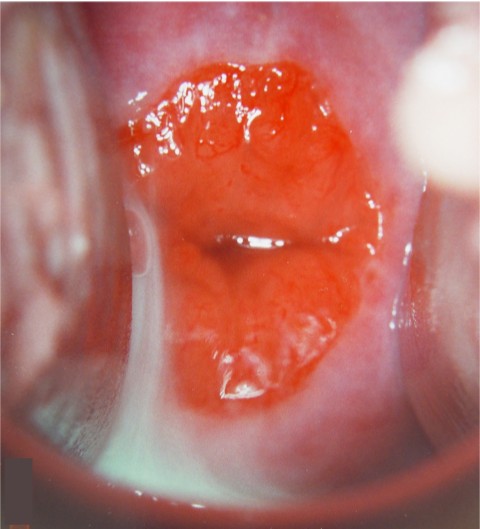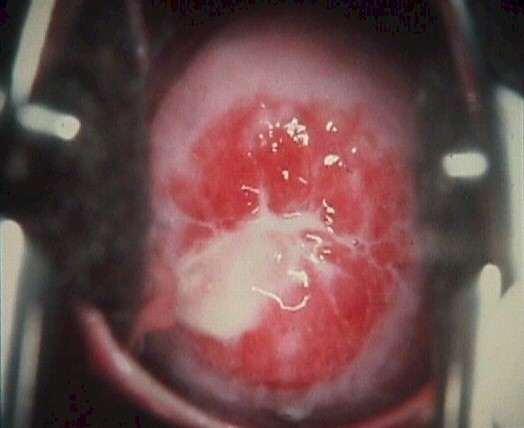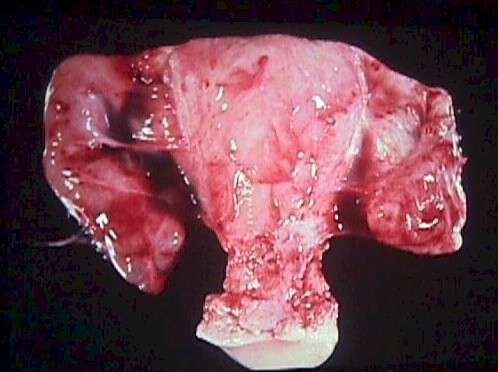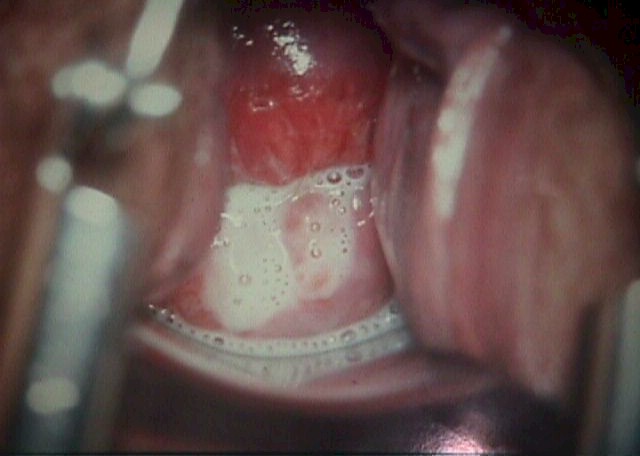|
Overview
The diagnosis of vaginal discharge is based on a History, Physical Exam,
and a few simple diagnostic tests.
History
 Ask the patient about itching, odor, color of discharge, painful
intercourse, or spotting after intercourse. Ask the patient about itching, odor, color of discharge, painful
intercourse, or spotting after intercourse.
-
Yeast causes intense itching
with a cheesy, dry discharge.
-
Gardnerella causes a
foul-smelling, thin white discharge.
-
Trichomonas gives irritation
and frothy white discharge.
-
Foreign body (lost tampon)
causes a foul-smelling black discharge.
-
Cervicitis causes a nondescript
discharge with deep dyspareunia
-
Chlamydia may cause a purulent
vaginal discharge, post-coital spotting, and deep dyspareunia.
-
Gonorrhea may cause a purulent
vaginal discharge and deep dyspareunia.
-
Cervical ectropion causes a
mucous, asymptomatic discharge.
Physical Exam
Inspect carefully for the presence of lesions, foreign bodies and odor.
Palpate to determine cervical tenderness.
-
Yeast has a thick white
cottage-cheese discharge and red vulva.
-
Gardnerella has a
foul-smelling, thin discharge.
-
Trichomonas has a profuse,
bubbly, frothy white discharge.
-
Foreign body is obvious and has
a terrible odor.
-
Cervicitis has a mucopurulent
cervical discharge and the cervix is tender to touch.
-
Chlamydia causes a friable
cervix but often has no other findings.
-
Gonorrhea causes a mucopurulent
cervical discharge and the cervix may be tender to touch.
-
Cervical ectropion looks like a
non-tender, fiery-red, friable button of tissue surrounding the cervical
os.
-
Infected/Rejected IUD
demonstrates a mucopurulent cervical discharge in the presence of an
IUD. The uterus is mildly tender.
-
Chancroid appears as an ulcer
with irregular margins, dirty-gray necrotic base and tenderness.
Laboratory
Obtain cultures for chlamydia,
gonorrhea, and Strept. You may test the vaginal discharge in any of 4 different
ways:
-
Test the pH. If >5.0, this
suggests Gardnerella.
-
Mix one drop of KOH with some
of the discharge on a microscope slide. The release of a bad-smelling
odor confirms Gardnerella.
-
Examine the KOH preparation
under the microscope ("Wet Mount").
Multiple strands of thread-like hyphae confirm the presence of yeast.
-
Mix one drop of saline with
some discharge ("Wet Mount"). Under the
microscope, large (bigger than WBCs), moving micro-organisms with four
flagella are trichomonads. Vaginal epithelial cells studded with coccoid
bacteria are "clue cells" signifying Gardnerella.
Read more about how to perform a wet mount.
Treatment
In addition to specific treatment of
any organism identified by culture or other test...
-
Any patient complaining of an
itchy vaginal discharge should probably be treated with an antifungal
agent (Monistat, Lotrimin, etc.) because of the high likelihood that
yeast is present, and
-
Any patient complaining of a
bad-smelling vaginal discharge should probably be treated with Flagyl
(or other reasonable substitute) because of the high likelihood that
Gardnerella is present.
 Ectropion,
Erosion or Eversion Ectropion,
Erosion or Eversion
This harmless condition is frequently mistaken for cervicitis.
Ectropion, erosion or eversion
(all synonyms) occurs when the normal squamo-columnar junction is
extended outward from the its; normal position at the opening of the
cervix.
Grossly, the cervix has a red,
friable ring of tissue around the os. Careful inspection with
magnification (6-10x) will reveal that this red tissue is the normal
tissue of the cervical canal, which has grown out onto the surface of
the cervix.
Cervical ectropion is very
common, particularly in younger women and those taking BCPs. It usually
causes no symptoms and need not be treated. If it is symptomatic,
producing a more or less constant, annoying, mucous discharge, cervical
cauterization will usually eliminate the problem.
When faced with a fiery red
button of tissue surrounding the cervical os, chlamydia culture (in
high-risk populations) and Pap smear should be performed. If these are
negative and the patient has no symptoms, this cervical ectropion should
be ignored.
Cervicitis
Inflammation or irritation of the cervix is rarely the cause of significant
morbidity. It is mainly a nuisance to the patient and a possible symptom of
underlying disease (gonorrhea, chlamydia).
Some patients with cervicitis note a
purulent vaginal discharge, deep dyspareunia, and spotting after intercourse,
while others may be symptom-free. The cervix is red, slightly tender, bleeds
easily, and a mucopurulent cervical discharge from the os is usually seen.
A Pap smear rules out malignancy.
Chlamydia culture and gonorrhea culture (for gram negative diplococci) are
routinely performed.
No treatment is necessary if the
patient is asymptomatic, the Pap smear is normal, and cultures are negative.
Antibiotics specific to the organism are temporarily effective and may be
curative. Cervical cautery may be needed to achieve permanent cure.

Chlamydia
This sexually-transmitted disease is caused by "chlamydia trachomatis". It
very commonly locates in the cervical canal although it can spread to
the fallopian tubes where it can cause PID.
Most women harboring chlamydia
will have no symptoms, but others complain of purulent vaginal
discharge, deep dyspareunia, and pelvic pain. There may be no
significant pelvic findings, but a friable cervix, mucopurulent cervical
discharge, pain on motion of the cervix, and tenderness in the adnexa
are suggestive.
The diagnosis is often made on
the basis of clinical suspicion but can be confirmed with chlamydia
culture. Such cultures are frequently performed routinely in high-risk
populations.
Treatment
Treating infected
patients prevents transmission to sex partners. In addition,
treating pregnant women usually prevents transmission of C.
trachomatis to infants during birth. Treatment of sex
partners helps to prevent reinfection of the index patient and
infection of other partners.
Coinfection with
C. trachomatis frequently occurs among patients who have
gonococcal infection; therefore, presumptive treatment of such
patients for chlamydia is appropriate (see
Gonococcal Infection, Dual Therapy for Gonococcal and Chlamydial
Infections). The following recommended treatment regimens and
alternative regimens cure infection and usually relieve symptoms.
Recommended Regimens
Azithromycin 1 g orally in a single dose
OR
Doxycycline 100 mg orally twice a day for 7 days
Alternative Regimens
Erythromycin base 500 mg orally four times a day
for 7 days
OR
Erythromycin ethylsuccinate 800 mg orally four
times a day for 7 days
OR
Ofloxacin 300 mg orally twice a day for 7 days
OR
Levofloxacin 500 mg orally once daily for 7 days
CDC 2006 Treatment Guidelines
|
Read the CDC Treatment Guidelines for Chlamydia
Foreign Body
Lost and forgotten tampons are the most common foreign body found in the vagina,
although other objects are occasionally found. Women with this problem complain of a
bad-smelling vaginal discharge which is brown or black in color. The foreign body can be
felt on digital exam or visualized with a speculum.
As soon as you suspect or identify a lost tampon or other object in the vagina,
immediately prepare a plastic bag to receive the object. As soon as it is retrieved, place
it in the bag and seal the bag since the anaerobic odor from the object will be extremely
penetrating and long-lasting.
Have the patient return in a few days for follow-up examination. Normally, no other
treatment is necessary, but patients who also complain of fever or demonstrate systemic
signs/symptoms of illness should be evaluated for possible toxic shock syndrome, an
extremely rare, but serious, complication of a retained tampon.
Gardnerella (Hemophilus, Bacterial Vaginosis)
The patient with this problem complains of a bad-smelling discharge which gets worse
after sex. Cultures will show the presence of "Gardnerella Vaginalis," the
bacteria associated with this condition. While this problem is commonly called
"Gardnerella," it is probably the associated anaerobic bacteria which actually
cause the bad odor and discharge.
The diagnosis is confirmed by the release of a bad odor when the discharge is mixed
with KOH ("whiff test"), a vaginal pH greater than 5.0, or the presence of
"clue cells" (vaginal epithelial cells studded with bacteria) in the vaginal
secretions.
Treatment
Recommended Regimens
Metronidazole 500 mg orally twice a day for 7
days
OR
Metronidazole gel, 0.75%, one full applicator (5
g) intravaginally, once a day for 5 days
OR
Clindamycin cream, 2%, one full applicator (5 g)
intravaginally at bedtime for 7 days
Patients should be
advised to avoid consuming alcohol during treatment with
metronidazole and for 24 hours thereafter. Clindamycin cream is
oil-based and might weaken latex condoms and diaphragms for 5 days
after use. Refer to clindamycin product labeling for additional
information. Topical clindamycin preparations should not be used in
the second half of pregnancy.
The recommended
metronidazole regimens are equally efficacious. One randomized trial
evaluated the clinical equivalency of intrav-aginal metronidazole
gel 0.75% once daily versus twice daily and demonstrated similar
cure rates 1 month after therapy
(157).
Alternative Regimens
Clindamycin 300 mg orally twice a day for 7 days
OR
Clindamycin ovules 100 mg intravaginally once at
bedtime for 3 days
CDC 2006
Treatment Guidelines
|
Read the CDC
Treatment Guidelines for Bacterial Vaginosis
Gonorrhea
This sexually-transmitted disease is caused by a gram negative diplococcus. The
organism grows easily in the cervical canal, where it can spread to the fallopian tubes,
causing PID. It may also infect the urethra, rectum or pharynx.
Many (perhaps most) women harboring the gonococcus will have no symptoms, but others
complain of purulent vaginal discharge, pelvic pain, and deep dyspareunia. There may be no
significant pelvic findings, but mucopurulent cervical discharge, pain on motion of the
cervix, and tenderness in the adnexa are all classical.
The diagnosis is often made on the basis of clinical suspicion but can be confirmed
with chocolate agar culture or gram stain.
Treatment
Ongoing data from CDC 's Gonococcal
Isolate Surveillance Project (GISP), including preliminary
findings from 2006, demonstrate that fluoroquinolone-resistant
gonorrhea is continuing to spread and is now widespread in the
United States. As a consequence, and as reported in the
MMWR, April 13, 2007, this class of antibiotics is no longer
recommended for the treatment of gonorrhea in the United States.
Treatment recommendations have been updated accordingly, and are
provided below.
Uncomplicated
Gonococcal Infections of the Cervix, Urethra, and Rectum*
Recommended Regimens
Ceftriaxone 125 mg IM in a single dose
OR
Cefixime 400 mg orally in a single dose or 400 mg
by suspension (200 mg/5ml)
PLUS
TREATMENT FOR CHLAMYDIA IF CHLAMYDIAL INFECTION IS NOT RULED OUT
* These regimens are recommended for all adult and adolescent
patients, regardless of travel history or sexual behavior.
Alternative Regimens
Spectinomycin† 2 g in a single intramuscular (IM)
dose
OR
Single-dose cephalosporin regimens
† Spectinomycin is currently not available in the United States.
Other single-dose
cephalosporin therapies that are considered alternative treatment
regimens for uncomplicated urogenital and anorectal gonococcal
infections include ceftizoxime 500 mg IM; or cefoxitin 2 g IM,
administered with probenecid 1 g orally; or cefotaxime 500 mg IM.
Some evidence indicates that cefpodoxime 400 mg and cefuroxime
axetil 1 g might be oral alternatives.
Uncomplicated
Gonococcal Infections of the Pharynx*
Recommended Regimens
Ceftriaxone 125 mg IM in a single dose
PLUS
TREATMENT FOR CHLAMYDIA IF CHLAMYDIAL INFECTION IS NOT RULED OUT
* This regimen is recommended for all adult and adolescent
patients, regardless of travel history or sexual behavior.
Disseminated
Gonococcal Infection (DGI)
Recommended Regimen
Ceftriaxone 1 g IM or IV every 24 hours
Alternative Regimens
Cefotaxime 1 g IV every 8 hours
OR
Ceftizoxime 1 g IV every 8 hours
OR
Spectinomycin† 2 g IM every 12 hour
† Spectinomycin is currently not available in the United States.
A cephalosporin-based
intravenous regimen is recommended for the initial treatment of DGI.
This is particularly important when gonorrhea is detected at mucosal
sites by nonculture tests. Spectinomycin is not currently available
in the United States; updated information regarding its availability
can be found at
http://www.cdc.gov/std/gonorrhea/arg. Treatment should be
continued for 24–48 hours after clinical improvement, at which time
therapy may be switched to one of the following regimens to complete
at least 1 week of antimicrobial therapy.
Cefixime
400 mg orally twice daily
OR
Cefixime 400 mg by suspension (200 mg/5ml) twice
daily
OR
Cefpodoxime 400 mg orally twice daily
Fluoroquinolones
may be an alternative treatment option if antimicrobial
susceptibility can be documented by culture. With use of nonculture
tests to diagnose N. gonorrhoeae increasing and with
local data on antimicrobial susceptibility less available,
laboratories should maintain the capacity to conduct such testing or
form partnerships with laboratories that can.
CDC
2007 Treatment Guidelines
|
Read the CDC Treatment Guidelines for
Gonorrhea |
Infected IUD
Sooner or later, as many as 5% of all intrauterine devices will become infected.
Patients with this problem usually notice mild lower abdominal pain, sometimes have a
vaginal discharge and fever, and may notice deep dyspareunia. The uterus is tender to
touch and one or both adnexa may also be tender.
 Treatment consists of removal of the IUD and broad-spectrum antibiotics. If the
symptoms are mild and the fever low-grade, oral antibiotics (amoxicillin, cephalosporins,
tetracycline, etc.) are very suitable. If the patient's fever is high, the symptoms
significant or she appears quite ill, IV antibiotics are a better choice (cefoxitin, or
metronidazole plus gentamicin, or clindamycin plus gentamicin). Treatment consists of removal of the IUD and broad-spectrum antibiotics. If the
symptoms are mild and the fever low-grade, oral antibiotics (amoxicillin, cephalosporins,
tetracycline, etc.) are very suitable. If the patient's fever is high, the symptoms
significant or she appears quite ill, IV antibiotics are a better choice (cefoxitin, or
metronidazole plus gentamicin, or clindamycin plus gentamicin).
If an IUD is present and the patient is complaining of any type of pelvic symptom, it
is wisest to remove the IUD, give antibiotics, and then worry about other possible causes
for the patient's symptoms.
IUDs can also be rejected without infection. Such patients
complain of pelvic pain and possibly bleeding. On pelvic exam, the IUD is seen protruding
from the cervix. It should be grasped with an instrument and gently removed. It cannot be
saved and should not be pushed back inside.
Read more about IUDs
PID: Mild
Gradual onset of mild bilateral pelvic pain with purulent vaginal
discharge is the typical complaint. Fever <100.4 and deep dyspareunia are common.
Moderate pain on motion of the cervix and uterus with purulent or
mucopurulent cervical discharge is found on examination. Gram-negative diplococci or
positive chlamydia culture may or may not be present. WBC may be minimally elevated or
normal.
Treatment
Oral therapy can be
considered for women with mild-to-moderately severe acute PID, as
the clinical outcomes among women treated with oral therapy are
similar to those treated with parenteral therapy. Women who do not
respond to oral therapy within 72 hours should be reevaluated to
confirm the diagnosis and should be administered parenteral therapy
on either an outpatient or in-patient basis.
Recommended Oral
Regimen
Ceftriaxone 250 mg IM in a single dose
PLUS
Doxycycline 100 mg orally twice a day for 14 days
WITH OR WITHOUT
Metronidazole 500 mg orally twice a day for 14
days
OR
Cefoxitin 2 g IM in a single dose and
Probenecid, 1 g orally administered concurrently in a
single dose
PLUS
Doxycycline 100 mg orally twice a day for 14 days
WITH OR WITHOUT
Metronidazole 500 mg orally twice a day for 14
days
OR
Other parenteral third-generation cephalosporin
(e.g., ceftizoxime or cefotaxime)
PLUS
Doxycycline 100 mg orally twice a day for 14 days
WITH OR WITHOUT
Metronidazole 500 mg orally twice a day for 14
days
Alternative
Oral Regimens
If parenteral
cephalosporin therapy is not feasible, use of fluoroquinolones
(levofloxacin 500 mg orally once daily or ofloxacin 400 mg twice
daily for 14 days) with or without metronidazole (500 mg orally
twice daily for 14 days) may be considered if the community
prevalence and individual risk (see “Gonococcal
Infections in Adolescents and Adults” in Sexually Transmitted
Disease Treatment Guidelines, 2006) of gonorrhea is low. Tests for
gonorrhea must be performed prior to instituting therapy and the
patient managed as follows if the test is positive:
- If NAAT test is
positive, parenteral cephalosporin is recommended.
- If culture for
gonorrhea is positive, treatment should be based on results of
antimicrobial susceptibility. If isolate is QRNG, or antimicrobial
susceptibility can’t be assessed, parenteral cephalosporin is
recommended.
Although information
regarding other outpatient regimens is limited, amoxicillin/clavulanic
acid and doxycycline or azithromycin with metronidazole has
demonstrated short-term clinical cure. No data has been published
regarding the use of oral cephalosporins for the treatment of PID.
CDC
2007 Treatment Guidelines
|
For further information, read the CDC Treatment Guidelines for PID
 PID: Moderate to Severe PID: Moderate to Severe
With moderate to severe PID, there is a gradual onset of moderate to
severe bilateral pelvic pain with purulent vaginal discharge, fever >100.4 (38.0),
lassitude, and headache. Symptoms more often occur shortly after the onset or completion
of menses.
Excruciating pain on movement of the cervix and uterus is characteristic
of this condition. Hypoactive bowel sounds, purulent cervical discharge, and abdominal
dissension are often present. Pelvic and abdominal tenderness is always bilateral except
in the presence of an IUD.
Gram-negative diplococci in cervical discharge or positive chlamydia
culture may or may not be present. WBC and ESR are elevated.
Treatment consists of bedrest, IV fluids, IV antibiotics, and NG suction
if ileus is present. Since surgery may be required, transfer to a definitive surgical
facility should be considered.
Treatment
Parenteral Treatment
Parenteral and oral
therapy appear to have similar clinical efficacy treating women with
PID of mild or moderate severity. Clinical experience should guide
decisions regarding transition to oral therapy, which usually can be
initiated within 24 hours of clinical improvement.
Recommended Parenteral
Regimen A
Cefotetan 2 g IV every 12 hours
OR
Cefoxitin 2 g IV every 6 hours
PLUS
Doxycycline 100 mg orally or IV every 12 hours
Recommmended Parenteral Regimen B
Clindamycin 900 mg IV every 8 hours
PLUS
Gentamicin loading dose IV or IM (2 mg/kg of body
weight), followed by a maintenance dose (1.5 mg/kg) every 8 hours.
Single daily dosing may be substituted.
Alternative Parenteral Regimens
Ampicillin/Sulbactam 3 g IV every 6 hours
PLUS
Doxycycline 100 mg orally or IV every 12 hours
CDC
2007 Treatment Guidelines
|
For further information, read the CDC Treatment Guidelines for PID
 Trichomonas Trichomonas
This microorganism, with its four flagella to propel it, is not a normal inhabitant of
the vagina. When present, it causes a profuse, frothy white or greenish vaginal discharge.
When the discharge is suspended in normal saline and examined under the microscope, the
typical movement of these large organisms (larger than white blood cells) is obvious.
Itching may be present, but this is inconsistent. Trichomonas is transmitted sexually and
you may wish to treat the sexual partner, particularly if this is a recurrent trichomonad
infection.
Treatment
Recommended
Regimens
Metronidazole 2 g orally in a single dose
OR
Tinidazole 2 g orally in a single dose
Alternative
Regimen
Metronidazole 500 mg orally twice a day for 7
days
CDC
2006 Treatment Guidelines
|
Read the CDC
Treatment Guidelines for Trichomonas
 Yeast (Monilia, Thrush) Yeast (Monilia, Thrush)
Vaginal yeast infections are common, monilial overgrowths in the vagina and vulvar
areas, characterized by itching,dryness, and a thick, cottage-cheese appearing vaginal
discharge. The vulva may be reddened and irritated to the point of tenderness.
Yeast thrives in damp, hot environments and women in such
circumstances are predisposed toward these infections. Women who take broad-spectrum
antibiotics are also predisposed towards these infections because of loss of the normal
vaginal bacterial flora.
Yeast organisms are normally present in most vaginas, but in small numbers. A yeast
infection, then, is not merely the presence of yeast, but the concentration of yeast in
such large numbers as to cause the typical symptoms of itching, burning and discharge.
Likewise, a "cure" doesn't mean eradication of all yeast organisms from the
vagina. Even if eradicated, they would soon be back because that is where they normally
live. A cure means that the concentration of yeast has been restored to normal and
symptoms have resolved.
The diagnosis is often made by history alone, and enhanced by the classical appearance
of a dry, cheesy vaginal discharge. It can be confirmed by microscopic visualization of
clusters of thread-like, branching Monilia organisms when the discharge is mixed with KOH.
Treatment
Short-course topical
formulations (i.e., single dose and regimens of 1–3 days)
effectively treat uncomplicated VVC. The topically applied azole
drugs are more effective than nystatin. Treatment with azoles
results in relief of symptoms and negative cultures in 80%–90% of
patients who complete therapy.
Recommended Regimens
Intravaginal Agents:
Butoconazole 2% cream 5 g intravaginally for 3
days*
OR
Butoconazole 2% cream 5 g
(Butaconazole1-sustained release), single intravaginal application
OR
Clotrimazole 1% cream 5 g intravaginally for 7–14
days*
OR
Clotrimazole 100 mg vaginal tablet for 7 days
OR
Clotrimazole 100 mg vaginal tablet, two tablets
for 3 days
OR
Miconazole2% cream 5 g intravaginally for 7 days*
OR
Miconazole 100 mg vaginal suppository, one
suppository for 7 days*
OR
Miconazole 200 mg vaginal suppository, one
suppository for 3 days*
OR
Miconazole 1,200 mg vaginal suppository, one
suppository for 1 day*
OR
Nystatin 100,000-unit vaginal tablet, one tablet
for 14 days
OR
Tioconazole 6.5% ointment 5 g intravaginally in a
single application*
OR
Terconazole 0.4% cream 5 g intravaginally for 7
days
OR
Terconazole 0.8% cream 5 g intravaginally for 3
days
OR
Terconazole 80 mg vaginal suppository, one
suppository for 3 days
Oral Agent:
Fluconazole 150 mg oral tablet, one tablet in
single dose
* Over-the-counter
preparations.
CDC
2006 Treatment Guidelines
|
Reoccurrences are common and can be treated the same as for initial infections. For
chronic recurrences, many patients find the use of a single applicator of Monistat 7 at
the onset of itching will abort the attack completely. Sexual partners need not be treated
unless they are symptomatic.
Read the CDC Treatment Guidelines for
Yeast
|